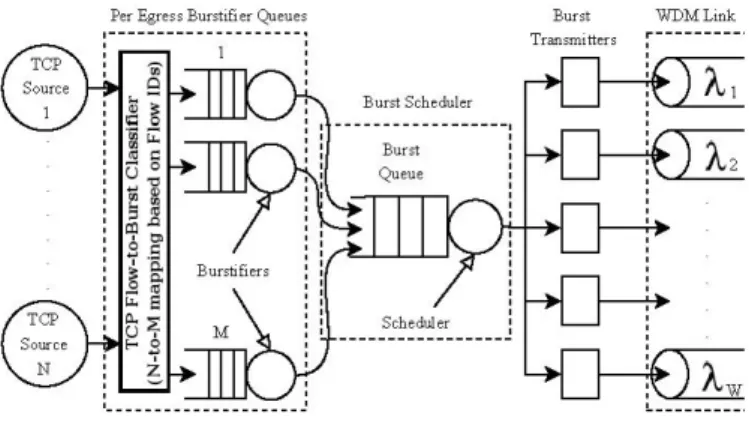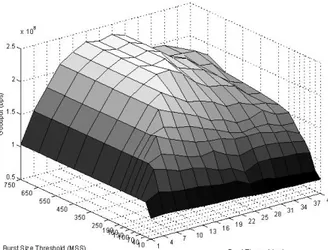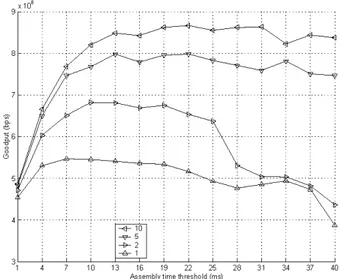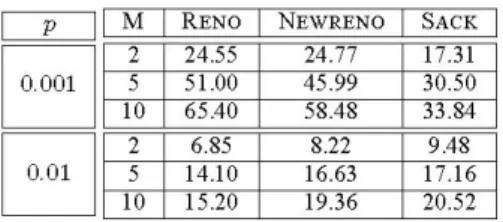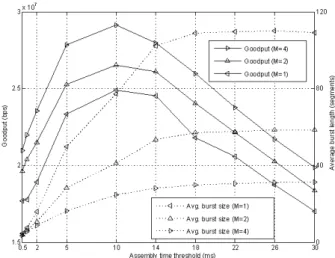Effect
of Number of
Burst
Assemblers
on
TCP
Performance in Optical
Burst Switching Networks
Guray Gurel and Ezhan Karasan
Department of Electrical and Electronics Engineering Bilkent University, 06800 Ankara, Turkey
Email: {guray,ezhan}@ee.bilkent.edu.tr
Abstract-Burst assembly mechanism is one of the
funda-mental factors that determine the performance of an optical
burst switching (OBS) network. In this paper,weinvestigate the
influence of number of burstifiers on TCP performance for an
OBS network. Anns2-based OBS network simulator is developed
for simulating the optical network. The goodput of TCP flows
between an ingress and an egress nodes traveling through an
optical network is studied for different values of the number
of assembly buffers per destination. First, the losses resulting
from the congestion in the core OBS network are modeled using
a burst independent Bernoulli loss model. Then, a background
burst traffic is generated to create contention at a core node
in order to realize a burst dependent loss model. Simulation
results show that for an OBS network employing timer-based
assembly algorithm, TCP goodput increases as the number of
burst assemblers is increased for both types of loss models.
The improvement from one burstifier to moderate number of
burst assemblers is significant (15-50% depending on the burst
loss probability, processing delay and the TCP version), but the
goodput difference between moderate number of buffers and
per-flowaggregation is relatively small, implying thatacost-effective
OBSedge switchimplementationshouldusemoderate numberof
assembly buffers per destination for enhanced TCPperformance.
I. INTRODUCTION
Increasing demand for services with very large bandwidth requirements, e.g., grid networks, facilitates the deployment of
optical networking technologies [1]. UsingDenseWavelength
Division Multiplexing (DWDM) technology, optical networks are able to meet the huge bandwidth requirements of future
Internet Protocol (IP) backbones [2]. Currently, IP routers
are interconnected with virtual circuits over synchronous op-tical networks(SONET) through multiprotocollabelswitching
(MPLS) [3]. However, optical circuit switching (OCS) is
not suitable for carrying bursty IP traffic with time-varying
bandwidth demand. In addition, delays during connection establishment and release increase the latency especially for services with small holding times. An alternative to OCS is
optical packet switching (OPS), which can adapt to changing
traffic demands and requires no reservation, but the optical
buffering andsignal processing technologieshavenotmatured
enough for possible deployment of OPS in core networks in
the nearfuture. Optical burstswitching (OBS) is proposedas a short-term feasible solution that can combine the strengths
and avoid the shortcomingsof OCS and OPS [4].Fig. 1 shows
atypical OBS network.
IPRouter EdgeRouter
Access
Link
EdgeRouter IPRouter Access
Liink
mt_
Fig. 1. An OBSnetwork
In OBS, the IP packets reaching the edge router are ag-gregated into bursts before being transmitted in the optical corenetwork. Theassembly algorithmattheedgerouterkeeps
track of the size of the burst and the delay experienced bythe first packet in the burst. A timer-based assembly algorithm creates a burst when the delay for the first packet reaches a timeout while a size-based algorithm creates a burst when the size of the burst reaches a threshold. A size/timer-based
hybrid burstifier creates a burst when either of the size or time thresholds is reached. As faras TCPthroughput isconcerned,
size-based burstification performs the worst, size/timer-based
performs better and timer-based performs the best
[5], [6].
The throughput degradation that results from the additional
burstassembly delay, called delaypenalty (DP) [5], increases
as assembly time is increased [3], [5], [7], [8]. An important
consequence of burst assembly is the combined loss or com-bined successful delivery of consecutive packets in a burst
belonging to the same TCP flow. The improvement in TCP
rate as aresult of this correlation is called correlation benefit,
and the correlation gain increases with the average number
of packets in a burst belonging to the same TCP flow [9].
This improvementisexplained bythe increased time between
two loss events, and it is referred to as the delayedfirst loss
(DFL) gain [5]. The average number of the packets inaburst
belonging to a particular flow depends onthe access network
bandwidth and assemblytimeout [5].
Performance improvement in OPS networks with larger
optical packetsis noted in[10].Itisseenthat theimprovement
oflargerburst sizeonthroughputgetsmoresignificantas drop
probability is decreased [8]. On the other hand, increasing
the burst size leads to performance deterioration as assembly
delay becomes dominant [3]. It is also shown that the TCP
performance degrades with aggregation as a result of the
synchronization between TCP flows sharing an aggregation
buffer [11]. This synchronization results from simultaneous decrease ofcongestion window sizes of TCP flows that have
packets in a lost burst.
Another effect of burst size on the loss performance is due to the voids formed between consecutive bursts [12]. If the burst control packets arriving to a switch have different residual offset times, some bursts are scheduled into voids formed between two reservations that have been made earlier. As a result of this, bursts with smaller sizes can be fit into these voids more easily resulting in a smaller loss probability for small-sized bursts. This burst length dependent losses do not occurifall bursts arriving at a switch have the same residual offset times, e.g., when they are all destined for the same egress node.
TCP flows are classified as slow when only one of their packets are found in a given burst, fast when their whole congestion window is found in the burst and medium other-wise [9].
Inthis paper, we focus on the effect of number of assembly buffers on TCP throughput. We consider two loss models. First, we study the case when the burst losses are
burst-size independent. Then, we consider the case of burst-size
dependent losses. We use an ns2-based
[13]
OBS networksimulator (n-OBS) [14] for studying the performance of several TCP implementations as the number of burstifiers is changed. We show for both loss models that the TCP
goodput increases significantly as the number of assembly
buffers per destination is increased since the effect of flow
synchronization is reduced. This improvement saturates as the
number of burst assemblers is increased further, e.g., when
per-flow aggregation is used. A cost-effective ingress node
implementation should use moderate number of buffers per destination for enhanced TCP performance. For the burst-length dependent loss case, we show that the TCP goodput increase is larger with per-flow aggregation for TCP flows having smaller residual offset times.
The organization of the paper is as follows: in section II,
the network model used in the simulations is presented. The effects of the number of burstifiers are discussed for the burst
independent loss model in Section III and for the burst-length
dependent loss model in Section IV. The conclusions of the
study arepresented in Section V.
II. NETWORK MODEL
Figure 2 shows the model used for the ingress node. The
burstifier queues shown are kept per-egress, and there is a group of M assembly buffers generating bursts destined for
the same egress node. For simplicity, the burstifier queues
for a single egress are shown in Figure 2. When multiple
destinations arepossible, the burstifier queue block containing
M burstifiers should be placed for each egress node. The number ofburstifiers, M< N, is chosen amongst divisors of N to allow simple mapping. Burstifiers use FIFO buffers to aggregatepackets. When aburst isgenerated byanyburstifier,
the burst is sent to the nodal burst scheduler. The scheduler
keeps track of the schedule on the wavelengths of the output
WDM links. If scheduler is able to find a suitable interval on an available wavelength over the first link of the route
Per EgressBurstifier Queues
,cP
BurstScheduler ~~~~~~~~~Burst u 0 ~~~~~Queue > E Burstifiers C) Z , 3 Scheduler e-N Burst WDMLink Transmitters -I,~~~~~~~
.[}o
iL sr~~
Fig. 2. Ingress node model
for this burst, the burst waits in the electronic burst queue until the reservation interval. The burst queue is necessary in order to avoid contention between burstscoming from different burstifiers.
The network topology used for studying the effects of burst
assembly on the performance of OBS networks is shown in
Figure 3 for the burst independent loss model. Burst length independent loss model is valid for the cases when all bursts
arrivingto aswitch have the same residual offset times or the
nodal processing delay is negligible with respect to the burst size. In this case, the core optical network is modeled as a
single fiber with Bernoulli distributed drop probability p in
01
->02
direction to account for losses due to contentions inthe corenetwork. The optical link in 02 ->
O1
direction andaccess links are lossless. On the reverse path, ACK packets
do not experience any drops or assembly delays.
Boa
Tpa,Bo
andTpo
denote the access link bandwidth, access linkdelay, optical link bandwidth and delay, respectively. Each
sourcenode
si
employs aninfinite FTPflow to the respective destinationdi,
1 < i < N.III. EFFECT OFASSEMBLYBUFFERINGFORBURST INDEPENDENT LOSSES
Inorder tostudyhow size/timer-based algorithm affects the
goodputs of TCPflows, it is evaluated using different values
for theassemblytimeout and burst size threshold. Given access
bandwidth,
Ban
the maximum burstsize, BM, dependsontheassembly time, TB,with the following relation [9]:
BM<T
(1)Ba
2.5 2, D5 1.5 0o (D A I19 1 1 1 16 19
Burst Size Threshold(MSS) Burst Timeout(ms)
Fig. 4. Total goodput for N = 10, M = 10 andp = 0.01 using TCP
Newreno
Similarly, equalityin(1) yields the minimum time, TB, needed
to assemble aburst of size BM. In otherwords, for those set
ofparameters where assembly time threshold is smaller than
this minimum time, the size/timer-based burstifier operates as
timer-based burstifier.
Figure 4 shows the performance of size/timer-based
as-sembly algorithm over a range of burst size thresholds and
assembly time thresholds (timeouts). Theparameters usedare
N 10, M = 10, p=0.01, Ba = 155Mbps, Tpa = lmsec,
BO 1Gbps and
Tp,
l0msec. The MSS of TCP sourcesareset to 1040 Bytes and the receive windowsareset to 10000
MSS. The employed TCP version isNewreno.
Forafixedtimeout, it is observed that the goodput increases asthe size threshold is increased until the maximum achievable
burst size correspondingto the timeout is reached. Increasing the burst size threshold further hasno effectongoodput since
the assembly algorithm acts as timer-based for larger size
thresholds.
For a fixed burst size threshold, the goodput increases as
the burstification timeout is increased for small timeouts. This is the region where DFL gain dominates the effects of DP andincreasing timeouts yieldbettergoodputs. However, once
the minimum assembly time corresponding to current size threshold is exceeded, DFL gain stays constant while the effects of DPbeginto dominate andconsequentlythegoodput decreases.
The largest burst size threshold in Figure 4 is larger than the maximum achievable burst size on the given timeout range. Therefore, for the largest burst size threshold, the
hybrid burstifier mechanism acts as a timer-based algorithm
for all timeouts. On the other hand, since size/timer-based algorithmreducesto size-based algorithmfor infinite timeout, theperformanceatthelargesttimeout reflects theperformance of the size-based algorithm.
Since the highest goodput is obtained by the timer-based algorithm, we resort to the timer-based burstification in the
rest of the paper for studying the effect of the number of
the burstifiers on TCP performance. Figures 5-10 show the
performance of the timer-based algoritm for p = 0.001 and
p=0.01 for TCP Reno, Newreno and Sack. Thegoodput
val-ues for M= 1,2,5and 10 are plotted together for comparison.
We observe that increasing the number of burst assemblers significantly improves the goodput for all three TCP versions since synchronization between large number of TCP flows is avoided as the number of burstifiers is increased. When a burst is lost in the optical core, all the sources that have packets in that burst decrease their congestion windows. In otherwords, flows sharing an aggregation buffer becomes synchronized.
In the full-aggregation case, i.e., M = 1, all flows 1- N
are synchronized and hence the optical link is underutilized. When the degree ofsynchronization is reducedby increasing
the number of burstifiers, the congestion windows of flows
belonging to different burst assemblers tend to balance each
other and the link is better utilized.
The plots also show that as the assembly time is increased,
goodputfirstincreases,then starts to decrease for all three TCP
versions. Inthe regionwhere goodput increases withtimeout,
thedelay penaltyis small andDFLgainisdominant,therefore
increasing the burst size increases the goodput. On the other hand, the improvement provided by DFL gain saturates after sometimeout value and the delay penalty beginsto dominate,
which causes the goodput to deteriorate.
Anotherimportant observation is that the rate of decrease in
goodputasthe timeout is increaseddependsonlossprobability
p.When p is large, thecongestionwindow cannot increaseto large values due to more frequent burst losses. In this case, the increase in the timeout does not increase the burst size
significantly and the increase in DFL gain with increasing
timeout is not significant. As a result, the goodput decreases morerapidly with increasing timeout due to the delay penalty. Onthe other hand, largerbursts are generated as the timeout is increased when p is small, and the DFL gain increases with the timeout. This partially compensates the effect of
the delay penalty, and the goodput does not degrade much
with the increasing throughput for all three TCP versions.
In addition, it is observed that a relatively low number of
buffers may perform close to the per-flow aggregation case. Since the cost of additional burstifiers can be compromised
bythe improvementin goodput, employingmoderate number
of buffers with respect to the number of flows constitutes a cost-effective solution.
Althoughall three TCP versions exhibit similar
characteris-tics as the timeout and the number of burstifiers are changed,
TCP Sack achieves the highest goodputamongthe three TCP versions. Sack outperforms the other two versions since it
quicklyretransmits the lost segments with selective
acknowl-edgements.Reno andNewrenohave very close performances,
however Newreno slightly outperforms Reno.
In Table I, the goodput enhancement of using multiple
burstifiers with respect to the single burstifier case, i.e., per
destinationburstification, is shown for different TCP versions,
number of TCP flows and loss probability. For N = 10 and
p =0.001, the goodput with per-flow burstification increases
burstifica-x10 9F 0o (D -- 10 v 5 D 2 A 1
Assembly time threshold(ms)
Fig.5. Total goodput with timer-based assembly forN M= 1, 2,5, 10andRenoTCP x10l 2.2r -4- 10 -vA- 1 10 13 16 19 22 25 28 31 34 37 Assembly time threshold (ms)
10,p =0.001, Fig. 7. Total goodput with timer-basedassembly for N
M=1, 2, 5, 10andNewreno TCP 10, p=0.001, x10 2.2r 1.8 1.6 n- 1.4-o14 12 08 06b 10 13 16 19 22 25 28 31 Assembly time threshold(ms)
-<- 10 --V 5 -D--2 34 37 40 . <- 10 -v- 5 -v--2 -A- 1 10 13 16 19 22 25 28 31 34 37 40 Assemblytime threshold(ms)
Fig. 6. Total goodput with timer-basedassembly for N = 10, p = 0.01,
M=1, 2,5,10andReno TCP
tion for different TCP versions. The goodput enhancement is
largest with Reno and smallest with Sack. We also observe
that the goodput achieved with M = 5 is very close to the
per-flow burstification case. For N = 10 and p = 0.01, the
goodputenhancement withper-flowburstification with respect
to per-destination burstification is about 15-20%. Similarly,
the goodput achieved with M = 5 is very close to the
per-flow burstification case. The burstification architecture at the
edge router should be designedtaking into account both the
goodput enhancement and additional management complexity
ofusing multiple burstifiers, and M = 5 seems to provide a
nice compromise for this case.
IV. BURST LENGTH DEPENDENTLOSSES
The burst-length dependent losses naturally occur at a
switch where arriving bursts have different residual offset times. This dependence is strongest for the flows having
Fig. 8. Totalgoodput with timer-based assembly forN = 10, p = 0.01,
M=1, 2, 5,10 andNewreno TCP x10l 10 < 10 v 5 D 2 A1 1 0o (D 10 13 16 19 22 25 28 31 34 37 40 Assemblytime threshold(ms)
Fig. 9. Total goodput with timer-basedassembly for N= 10,p =0.001,
M=1, 2,5, 10and Sack TCP
9 F
\x,
,--ill
Fig. 11. Topology used in simulations propagation delay. 16 D1.6 0o < 10 V 5 D> 2 A 1 10 13 16 19 22 25 28 31 34 37 40
Assemblytime threshold(ms)
Fig. 10. Total goodput with timer-based assembly for N
M=1, 2,5, 10 and Sack TCP =10,p =0.01,
TABLE I
PERCENTAGEGOODPUT INCREASE VERSUSNUMBEROF BURSTIFIERS FOR
DIFFERENTTCPVERSIONS AND LOSS PROBABILITY
P M RENO NEWRENO SACK
2 24.55 24.77 17.31 0.001 5 51.00 45.99 30.50 10 65.40 58.48 33.84 2 6.85 8.22 9.48 0.01 5 14.10 16.63 17.16 10 15.20 19.36 20.52
smaller residual offset times, and the dependence becomes weaker for flows having larger residual offset times. For the flow with thelargestresidual offsettime,the burst lossesoccur
independent of their sizes.
Figure 11 shows the network topology used for studying
the effects of burst length dependentlosses. Sources S -SN employ an infinite FTP flow to the respective destination D1-DN (N=20). Optical links have 1 Gbps bandwidth and
2.5 msec propagation delay. The background burst generator
produces bursts whose sizes are exponentially distributed with
1/,u and burst arrivals are Poisson with rate A. All bursts are destined uniformly to the five egress nodes connected to
D1-D20. Access links have 50 Mbps bandwidth and 1 msec
1.c=B-=7 8-=B-13 14-=B-19 20-=B-25 26-=B-31 32-=B-3738-=B-43 44-=B-49 50-=B-55 56-=B-61
BurstLength(B), packets
Fig. 12. Loss probabilityvs.burst length for differentegressnodes
Figure 12 shows the lossprobability for each egressnodeas afunction of the burstlength with theparameters1/, = 200,u
sec, 1/A = 2msec, M = 1, the nodal processing delay
A = 50,usec and the assembly timeout T = lOmsec. The
statistics of the generated bursts is grouped into 10 bins accordingtothe number ofpackets intheburst, whichranges
from 1 to a maximum value of 60 packets. It can be seen
that the loss probability is relatively high for the flows with smaller residual offsettimes, as expected. Moreover, the loss
probability increasesasthe burst size increases. The impact of
void filling mechanism in the core router scheduler becomes important for those bursts that are closer to their destinations becausetheyneedtofit in the voids created beforehandbythe bursts that have largerresidual offset times. Consequently, the dependenceof the lossprobabilityonthe burst size isstrongest
for the bursts destinedto D1-D4. Such a correlation isnot
observed for the bursts destinedto D17 -D20.
In addition to the mechanisms mentioned in [5] such as
DP, the loss penalty and correlation gain, this observation brings forward another critical factor in analysis of TCP performance in OBS networks. The significance of the burst length dependent losses depends on the residual offset time,
per-hop processing delay (A) and the burst transmission time. Figures 13 and 14 plot the goodput and the average burst
size as a function of the burst assembly timeout for the
x 10-2.2 1.8, 0.01/
W-I.ixi,\T
0.05_ 0045_ 0 Dl-D, --<- D5-D8 V -Dg-D12 > D13-D16 -A D17-D20 U.U4t, 0.04 0.035 - 0.03 rL-54 0 L0.025 0.02 0.015 wnearest and farthest egress nodes, respectively, and for different values of the number of burstification buffers, M, using the parameters 1/,u = 200,u sec, 1/A = 2msec, A = 50,usec,
when TCP Reno is used. We observe that for both destinations the average goodputs increase with the number of burstifiers. It is also observed that the average burst size increases linearly with the assembly timeout for flows destined to D17- D20. On the other hand, the average burst size first increases and then saturates for the flows destined to D1 -D4. This is due tothe fact that the TCP flows destined to D1 -D4 experience much more frequent burst losses and consequently they do not achieve very large congestion windows. The saturation of the averageburst sizes coupledwith the additional assembly delay
cause the drop inthe average goodput for flows destined for D1 -D4 as the assembly timeout increases. On the other
hand,
the TCP flows destined for D17 -D20 can achievevery large congestion windows and the resulting burst sizes
increase with the assembly timeout. The correlation benefit achieved by having longer bursts is partially compensated
by the delay penalty, and the average TCP goodput does
significantly changeasthe burstassemblytimeout is increased.
Weobserve from Figures 13 and 14that the flows destined for D17- D20 achieve much higher goodput compared with the flows destined for D1 -D4. Althoughthe flows destined for D17- D20 experience larger delays, their much smaller loss probability results in higher goodput.
The comparison of Figures 13 and 14 also reveal that the maximum goodput for the flows destined for D1 -D4 are achieved at smaller values of the burst assemblytimeout
comparedwith the flows destined for D17-D20. Infact, the
maximum goodput is achieved before the burst size saturates for the flows destined for D1-D4. This is due to the fact that the lossprobabilityincreasessignificantlyasthe burst size increases for the flows destined forD1-D4 as it was shown inFigure 12. Although the correlation gain is increasing with the burst size, the burst length dependent nature of the burst losses causes the averagegoodputto startdecreasingbefore the average burst size reaches its maximum.A similar behavior is notobserved inFigure 14since the burst losses is independent of the burst size for the flows destined for D17- D20.
The performance improvement in the maximum average
goodputs achieved by using M= 2 and M = 4 with respect
to the case of M = 1 for TCP Reno and TCP Sack are
shown in Tables II and III, respectively. The results show that the improvement inthe average goodput is maximum for the flows destined for closer egress nodes, and the average
goodput improvement generally increases with the increasing
nodalprocessing delay
A.
The improvements are inthe range of 17-35% for the closest nodes and the average goodputimprovement over all destinations is 6-37% for TCP Reno
and M = 4. For the case of M = 2, the average goodput
increases are in the range of 3-10%compared to M= 1. The
performance improvements for TCP Sack are slightly larger
compared to TCP Reno.
x10
Fig. 13. Goodput and egressnode 3 120 1(n -80 a) E o) a) A m a) Z H-~ (n a) 140 >
average burst size vs assemblytime threshold for
x10
D Goodput (M=4)
A Goodput (M=2) < Goodput(M=1)
Avg.burst size(M=1) Avg. burst size (M=2) Avg. burst size (M=4)
615
Assemblytimethreshold(ms)
Fig. 14. Goodput and
egress node 7 average burst size vs assembly time threshold for
V. CONCLUSION
The performance of TCP overOBS networks is studied in
this paper intermsof the number of burstifiers usedattheedge
routers. Increasing the number of burst assemblers per
desti-nation reduces thenegative effects of synchronization between
TCPflowsoccuringas aresult of lost burstscontaining packets
belongingto multiple TCP flows.We show that TCP goodput
is increased significantly when edge routers with multiple
burstifiers per destinationare used, and thegoodputincreases as the number of burstifiers increase. This conclusion holds for different TCP versions and different burst loss models. We argue that the edge router architecture can be designed
with less number of burst assemblers than theper-destination
burstification in order to reduce the complexity ofmanaging
large number of buffers whileachieving nearly the maximum
goodput. -o
(9
-o
TABLE II
PERCENTAGEGOODPUT INCREASE AS A FUNCTION OF THE NUMBER OF
BURSTIFIERS FORTCP RENO
Destination A (,usec) M 1-4 5-8 9-12 13-16 17-20 Avg. 50 4 16.91 8.15 6.86 2.91 2.43 6.22 50 2 6.47 4.22 4.19 3.28 1.36 3.87 100 4 34.82 26.83 8.61 6.21 1.89 6.91 100 2 13.91 7.78 2.85 4.91 0.82 2.69 200 4 26.78 35.79 31.73 6.70 15.52 23.15 200 2 13.86 14.86 12.36 4.31 6.01 6.70 500 4 26.49 27.83 31.22 34.97 15.95 36.92 500 2 13.36 10.94 14.53 16.76 3.27 10.24 TABLE III
PERCENTAGEGOODPUT INCREASE AS A FUNCTION OF THE NUMBER OF BURSTIFIERS FORTCP SACK
Destination A (,usec) M 1-4 5-8 9-12 13-16 17-20 Avg. 50 4 39.41 8.47 8.79 5.43 0.38 4.91 50 2 19.72 4.76 3.73 3.15 0.04 3.03 100 4 48.81 54.93 13.05 10.35 0.62 6.33 100 2 26.21 25.25 6.09 8.68 0.46 2.72 200 4 44.79 57.58 45.30 6.91 0.46 24.45 200 2 25.43 25.01 26.07 4.74 0.00 4.35 500 4 47.83 38.83 48.91 54.20 1.29 37.88 500 2 24.76 17.81 25.86 25.44 0.73 8.07
[12] K. Dolzer,C. Gauger, J. Spath, and S. Bodamer, Evaluation of reserva-tion mechanisms for optical burst switching, AEU International Journal of Electronics and Communications, vol.55(1),pp.18-26, January 2001. [13] Network Simulator 2, developed by L. Berkeley Network Laboratory
andUniversity of California Berkeley, http://www.isi.edu/nsnam/ns [14] G. Gurel,O. Alparslan and E. Karasan, nOBS: an ns2 basedsimulation
toolfor TCP performance evaluation in OBS networks, Proc. Simulation Tools for Research and Education in Optical Networks, Oct. 2005, France.
ACKNOWLEDGMENT
This work is partially supported by FP6 IST e-Photon/ONe
NoEprojectandbythe Scienctific andTechnologicalResearch
Council ofTurkey (TUBITAK) under project 104E047.
REFERENCES
[1] M.Listanti, V. Eramo,R.Sabella, Architectural and technologicalissues for future optical Internet networks, IEEE Communications Magazine,
Vol. 38,No. 9,September 2000,pp. 82-92.
[2] J. Turner, Terabit burstswitching, J. High Speed Networks, Vol. 8, pp. 3-16, 1999.
[3] S. Yao, F. Xue, B. Mukherjee, S. J. B. Yoo, S. Dixit, Electrical ingressbuffering and traffic aggregation foropticalpacket switching and their effect on TCP-levelperformance in optical mesh networks, IEEE Communications Magazine40 (9) (2002)66-72.
[4] C. Qiao andM. Yoo, Optical burst switching (OBS) -A newparadigm foranoptical internet,J. High Speed Networks, Vol. 8, pp. 69-84, 1999. [5] X. Yu, J. Li, X. Cao, Y Chen and C. Qiao, Traffic statistics and performance evaluation in optical burst switchednetworks, IEEE/OSA Journal ofLightwave Technology, Vol. 22(12),pp.2722-2738,Dec.2004. [6] X. Cao, J. Li,Y Chen, C. Qiao, Assembling TCPIIP packetsinoptical burst switchednetworks, Proc. IEEEGLOBECOM'02, November 2002, pp.2808-2812.
[7] X. Yu, C. Qiao, Y Liu, and D. Towsley, Performance evaluation of TCPimplementations inOBSnetworks, Tech. Rep. 2003-13,CSEDept., SUNY, Buffalo, NY, 2003.
[8] S. Gowda, R.K. Shenai, K.M. Sivalingam, H.C. Cankaya, Performance evaluation ofTCP over optical burst-switched (OBS) WDMnetworks, Proc. IEEEICC'03,May2003,pp. 1433-1437.
[9] A.Detti,M.Listanti, Impact ofsegments aggregationonTCP Renoflows
inopticalburstswitching networks,Proc. IEEEINFOCOM'02, 2002, pp.
1803-1812.
[10] Jingyi He, S.-H. Gary Chan, TCPandUDPperformanceforInternet overoptical packet-switched networks, Computer Networks 45(4): 505-521 (2004).
[11] D.Hong, France,F.Poppe,J.Reynier, F.Baccelli,G.Petit, Theimpact
of burstificationon TCPthroughput inopticalburstswitching networks,

